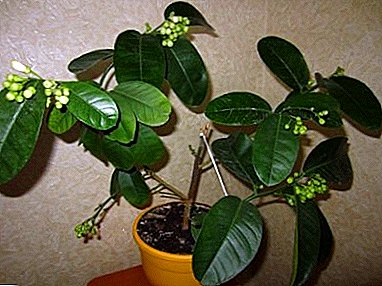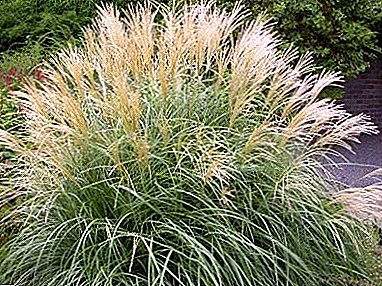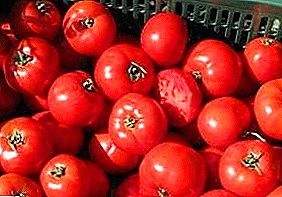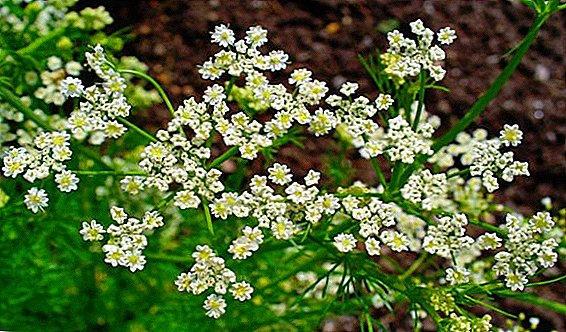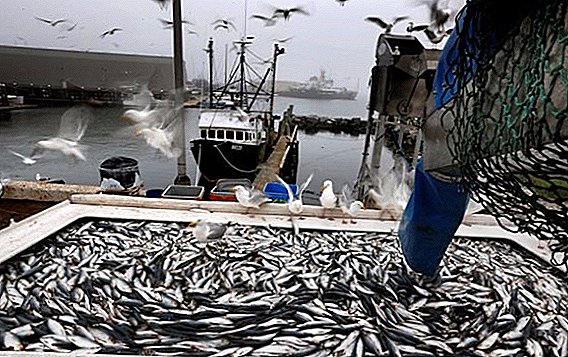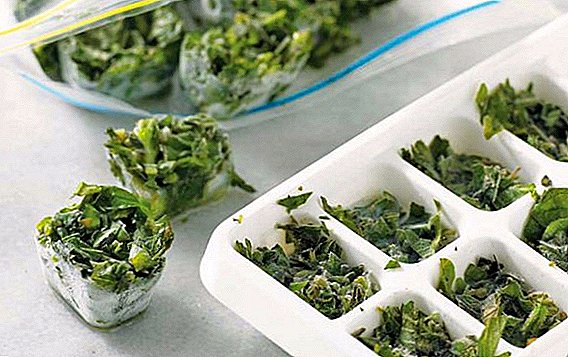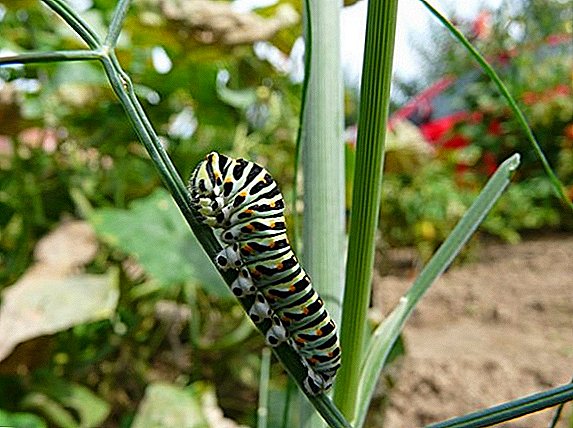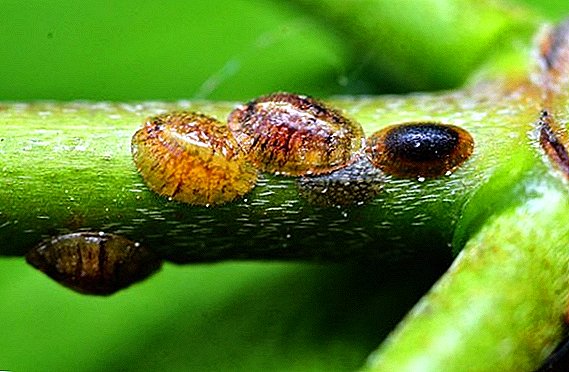 Grapes - one of the oldest and most respected human cultures. Today it is one of the most common garden plants. For the first time taking up the cultivation of the vine, you can face a number of its diseases and pests. One of these pests is scythe.
Grapes - one of the oldest and most respected human cultures. Today it is one of the most common garden plants. For the first time taking up the cultivation of the vine, you can face a number of its diseases and pests. One of these pests is scythe.
What does a pest look like?
Shchitovki - small insects in size from 0.5 to 5 mm, covered with a semicircular dome-shaped, rarely elongated shell - wax shield. Live, as a rule, on woody plants.  The color of the shield may be different, from white or gray to orange, brown or black, and depends on the species of the insect.
The color of the shield may be different, from white or gray to orange, brown or black, and depends on the species of the insect.
There are many types of shield and pseudo shield. Gardeners unite them by their similarity in appearance, behavior, and harm done. The females of the shield insects are larger than the males, they move only at an early age until the shield has formed, and then they sit motionless on the plant.
Did you know? There are more than 2.4 thousand species of these pests, and every year, along with products and plants, we bring in all new species that have their own color and characteristics.The main harm is caused by them and their larvae. Males in some species of scale insects can even fly, but live no more than a couple of days and do not cause harm.

What harm is it
Shchitovka eat plant juices. An adult female, overgrown with a flap, loses all external organs, except for the proboscis. Through him, she sucks vegetable juices.
Having multiplied strongly, these pests take nutrients from the donor plant, as a result, it weakens, slows in growth, leaves and fruits wither from it. The larvae cause similar harm.
Check out such grapes as "Chameleon", "Delight", "Veles", "Arcadia", "Cardinal", "Original", "Annie", "Laura", "Timur", "Augustine", "Libya" , "Rochefort", "Amur", "Harold".In addition, insects produce a sticky liquid, the so-called pad or honeydew. It develops soot (black) fungus, which clogs the respiratory stomata of the plant, which again leads to the deterioration of its condition.

First signs of failure
The fact that it is time to deal with the shield on the grapes is indicated by brown, brown or whitish scales on the leaves, both round and oblong, often accompanied by an oily bloom. The color of these scales (insect flaps) depends on the type of pest.
Most often, grapes are amazing acacia spatulait is hazel shield: the back is round, brown or brown-red. Keeps on the underside of grape leaves.
The remaining species infect grapes less frequently.
- California shield - the shield is white at first, then it turns black.
- Brown shield - flap brownish, kept on the upper side of the leaves.
- Palm tree - the shield is transparent, whitish or grayish, lives on the underside of the leaves.
- Oily Mask - strongly convex, dark brown. Lives on the stems or along the veins of leaves.

Prevention and agrotechnical rules
Shchitovka, especially adult individuals, very tenacious, it does not affect the majority of insecticides. Therefore, the fight with the shield, found in your garden, a thankless task. To avoid this, it is necessary to adhere to a number of rules.
Did you know? For the first time, some species of shield insects were described by entomologists at the end of the 18th and the beginning of the 19th century, they were named after their host plants.
- In the fall and in early spring, the soil in the garden is dug up, fertilizers are applied, pruning of dried branches and twigs are made, and root-growing shoots are shed.
- Moss and lichen are cleared from the bark, pests love to hide under them.
- It is advisable to purchase new seedlings only in specialized nurseries, and carefully examine them before planting with a magnifying glass.
- The pest can get on the vine during vaccination. Cuttings must also be carefully checked.
- Before sheltering for the winter, the vine is cleaned of old bark and treated with a solution of tar soap.

Active fight
If the shield is still found on the grapes, not all control measures will be equally effective against insects at different stages of development. From larvae and juveniles, you can, as a rule, get rid of with insecticides or other poison-cleansing agents, spraying or rubbing the affected areas.
Few insecticides act on scutum-covered adults or eggs covered by them. In this case, it is necessary to mechanically clean the affected areas.
If shchitovki densely captured certain areas of the vine, as shown in the photo, and the measures taken to combat them do not help, you have to sacrifice not only foliage and branches, but whole vines.  Over the centuries-old history of viticulture, many popular methods of dealing with this scourge have been developed, as well as many effective chemicals.
Over the centuries-old history of viticulture, many popular methods of dealing with this scourge have been developed, as well as many effective chemicals.
You will be interested to know about the description and methods of pest control of grapes.
Chemicals
The chemical industry has developed a number of drugs to combat such insects.
- "Admiral" (emulsion concentrate) - a narrowly targeted remedy for the California scale; The active ingredient, pyriproxyfen (juvenoid), causes changes in the development of the insect, affecting their next generations. Almost safe for humans and pollinating insects. It is applied in early spring and summer. There are restrictions on the use near fish ponds.
- Aktara is a systemic insecticide with a fairly wide range of effects, including against the shield insect. It is produced in water-dispersible granules or in the form of a suspension concentrate. The active substance is thiamethoxam, it works both in the soil (by watering for three days, reaching the top of the plants) and by spraying, penetrating the leaves in a day. On pests acts enterocontact, they die after 24 hours. Apply with warm dry weather. Compatible with other insecticides.

- "Actellic" (emulsion concentrate) - non-systemic insecticide of a very wide range of effects. Substance - pyrimiphos-methyl, the effects of intestinal-contact. Apply through spraying. The death of insects occurs within three hours, the protective action lasts up to three weeks.
- "Konfidor Extra" (water dispersible granules) - a systemic insecticide from sucking and gnawing insects. The substance is imidacloprid, acts in the intestinal-contact manner, applied by spraying. Protection is valid up to 30 days.
- "Bi-58 New" (emulsion concentrate) - systemic insecticide with a wide range of effects. The damaging substance - dithiophosphoric acid, has a contact and intestinal effects. Apply by spraying twice. Protective effect lasts up to 20 days.
Important! "Bi-58" very dangerous for fish and other aquatic animals. It is not recommended to use near fishery reservoirs.
- "Bona Forte" - an insecticide used to combat the scythe, mealybug, whitefly. Insects die for several hours, protection lasts up to three weeks.

Folk remedies
Folk remedies are not as effective as industrial chemicals, they do not allow to process large vineyards, but their use at higher costs is safe for you, the grapes and the environment.
Important! "Aktara" has a hazard class for bees (border zone 4-5 km).Insects can be cleaned with a cloth or a toothbrush dipped in soapy water. In addition, you can use a kerosene solution, soap-kerosene, soap-alcohol or alcohol solutions. In this process the plants several times.
You can spray the affected plants with a solution of tar soap (10 g of soap per 1 liter of water) or a decoction of wood ash (300 g of ash per 1 liter of boiling water, boil for 30 minutes)  To reduce the damage caused by reducing the number of waterings of grapes, because these pests need moisture for reproduction.
To reduce the damage caused by reducing the number of waterings of grapes, because these pests need moisture for reproduction.
In general, scab, is a typical pest of vineyards and often have to deal with it. If these are small vineyards at home or in the country, it is better to use folk remedies. They are safe for others, do not harm the grapes, but require great effort.
In case of critical damage to grapes or processing large areas, it is better to use industrial chemicals.


